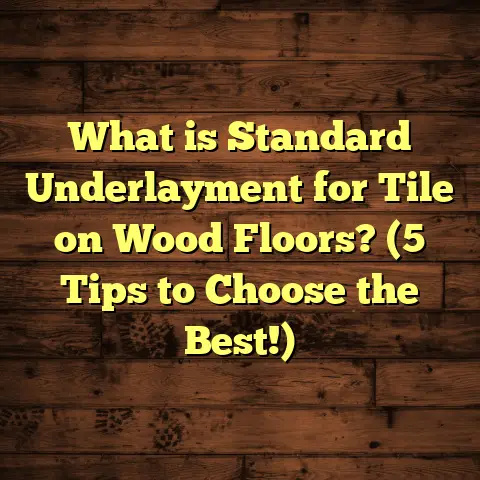What is a Floor Made Of? (5 Essential Materials Explained)
What is a Floor Made Of?
Have you ever stepped into a room and immediately noticed how the floor “feels” beneath your feet? I know I have. Sometimes it’s that smooth, solid feeling of hardwood; other times it’s the cushioned softness of carpet or the cool, sleek surface of tile. But have you ever stopped to think about what really makes up a floor? What materials are involved, and why do they behave so differently? I’ve been in the flooring business for years, and I’ve seen firsthand how understanding these materials can save you time, money, and headaches.
Choosing the right flooring material is more than an aesthetic choice. It’s about durability, comfort, maintenance, cost, and how the floor fits into your lifestyle. Many people jump into flooring decisions based on looks alone and end up frustrated when their floors don’t hold up or feel right.
Let’s get practical. I want to share my experience with five essential flooring materials that most homes and commercial spaces use. I’ll break down what each one is made of, how it performs, how much it costs, and what to watch out for. Along the way, I’ll share stories from my projects, data-backed insights, and tips you can apply directly to your next flooring project.
Hardwood: The Timeless Classic That Never Goes Out of Style
I still remember my first hardwood flooring installation like it was yesterday. The client wanted a warm, inviting living room with that classic wood look—something that felt natural and would stand the test of time. After sanding, staining, and sealing the floor, the transformation was incredible. The room went from cold and empty to cozy and elegant.
What Hardwood Floors Are Made Of
Hardwood floors come from solid timber harvested from trees such as oak, maple, cherry, walnut, and hickory. Each species has its own grain pattern, hardness level (measured by the Janka hardness test), color range, and cost.
- Oak: The most popular hardwood in North America; durable and versatile.
- Maple: Known for its smooth grain and hardness.
- Cherry: Rich reddish hues that deepen with age.
- Walnut: Darker tones for a luxurious feel.
- Hickory: Very hard and rustic-looking with dramatic grain patterns.
The wood planks are typically milled into different thicknesses (commonly 3/4 inch for solid hardwood) and widths.
Why Hardwood Is Worth Considering
Durability: Hardwood is tough. For example, white oak scores about 1360 on the Janka scale, making it able to handle heavy foot traffic without denting easily. Compared to softer woods like pine (which scores around 420), hardwood is a long-term investment.
Refinishing: One of the biggest advantages is that hardwood floors can be sanded down and refinished multiple times. Think of it like restoring an old painting—each refinish removes scratches and dents, bringing back that fresh wood look.
Air Quality: Unlike carpet that can trap dust and allergens, hardwood floors are easier to keep clean and better for indoor air quality.
Hardwood Flooring Costs: What You Can Expect
Prices vary based on wood species and finish but generally fall between $8 to $14 per square foot for materials and installation combined. Exotic woods push that higher; Brazilian cherry or teak can cost $15+ per square foot.
A 1500-square-foot home can cost anywhere from $12,000 to $21,000 to install hardwood floors throughout. Yes, it’s an investment—but many homeowners see this as adding value to their property.
Maintenance Tips That Have Worked for Me
- Place felt pads under furniture legs to prevent scratches.
- Use area rugs near entrances to catch dirt.
- Wipe up spills immediately to avoid stains or water damage.
- Schedule refinishing every 10-15 years depending on wear.
A Real-Life Example
A client in Boston had hardwood installed 40 years ago. When I visited recently to refinish their floors, I was amazed at how well the wood had held up despite three kids, pets, and parties over the years. A few scratches here and there were all that showed signs of wear—and sanding brought it back to life. This experience reinforced how hardwood truly lasts when cared for properly.
Laminate: Affordable Style Without Breaking the Bank
When laminate flooring first came onto the scene in the ’90s, it got a bad rap for being cheap-looking and prone to damage. That changed dramatically in recent years with advances in technology.
What Laminate Flooring Is Made Of
Laminate is essentially a multi-layer synthetic product fused together through a lamination process:
- Wear Layer: A transparent top coat that protects against scratches and stains.
- Design Layer: A high-resolution photographic image that mimics wood, stone, or tile.
- Core Layer: A dense fiberboard (usually HDF – High-Density Fiberboard) that provides stability.
- Backing Layer: Adds moisture resistance and balances the plank.
Unlike hardwood, laminate does not contain real wood on the surface—it’s all an image protected by resin overlays.
Why Laminate Has Become Popular
Cost-Effective: You can install laminate floors for as low as $1 to $3 per square foot for materials alone. Including installation, expect $3 to $8 per square foot—much cheaper than hardwood.
Ease of Installation: Most laminate floors now come with click-lock systems that snap together without glue or nails. This makes them perfect for DIYers or quick installs.
Durability: The wear layer protects well against everyday scratches and stains. It’s great for families with kids or pets where spills happen frequently.
Limitations You Should Know
- Moisture Sensitivity: Laminate doesn’t like water. Excessive moisture can cause swelling or warping.
- Not Refinishable: Once worn out or damaged, laminate must be replaced entirely.
- Sound: Laminate tends to be louder underfoot unless proper underlayment is used.
Using Laminate in Real Life
In one rental renovation project, I recommended laminate flooring because the landlord wanted something durable yet inexpensive. The tenants had pets and were known for occasional spills, but after three years with no major issues or replacements needed, the landlord was very happy with the choice.
Maintenance Tips
- Use a damp mop instead of soaking wet.
- Avoid abrasive cleaners.
- Install underlayment to reduce noise and add cushion.
Vinyl Flooring: Modern Durability Meets Style
Vinyl flooring has transformed from a cheap option into a highly versatile material that can handle moisture-heavy areas while looking great.
What Vinyl Floors Are Made Of
Vinyl flooring usually consists of several layers:
- Wear Layer: Transparent top coat protecting against scratches.
- Print Layer: The design surface showing patterns such as wood grain or stone.
- Core Layer: Rigid vinyl provides stability in luxury vinyl planks (LVP) or tiles (LVT).
- Backing Layer: Adds support and moisture resistance.
There are different types:
- Sheet Vinyl: Comes in large rolls; good for moisture areas but less realistic designs.
- Luxury Vinyl Plank (LVP): Planks that mimic wood look closely.
- Luxury Vinyl Tile (LVT): Tiles mimicking stone or ceramic.
Why Vinyl Is a Great Choice
- Waterproof: Unlike laminate or hardwood, vinyl can handle spills and humidity without damage.
- Comfort: Softer underfoot compared to tile or hardwood thanks to thicker wear layers.
- Affordable: Installation costs range from $2 to $7 per square foot depending on quality.
I recently installed luxury vinyl planks in a kitchen remodel where the client wanted wood aesthetics but needed waterproof flooring due to frequent spills. The floor looked fantastic and held up well even after three years of heavy use.
Things to Watch Out For
- Low-quality vinyl can yellow over time.
- Cheap vinyl sheets may emit odors initially—look for low-VOC products.
- Subfloor must be smooth; imperfections show through thin vinyl sheets.
Maintenance Tips I Recommend
- Sweep regularly to prevent grit scratching surface.
- Clean with mild detergent; avoid harsh chemicals.
- Place mats at entryways to trap dirt.
Tile Flooring: Durable Beauty That Lasts Generations
Tile floors are often chosen for kitchens and bathrooms because they resist water and stains better than almost any other material.
What Tile Floors Are Made Of
Two main types dominate:
- Ceramic Tile: Made from red or white clay fired at high temperatures; finished with a hard glaze.
- Porcelain Tile: A denser type of ceramic fired at higher temperatures; usually more durable and less porous.
Natural stone tiles like marble, slate, or granite are also popular but more expensive and require more maintenance.
Why Tile Works Well
- Longevity: Properly installed tile floors can last 50+ years.
- Water Resistance: Glazed tiles don’t absorb water—ideal for bathrooms.
- Design Flexibility: You can create intricate patterns with various shapes and sizes.
For one bathroom renovation I handled recently, we used large-format porcelain tiles with heated floors underneath—a combination that felt luxurious and practical during chilly winters.
Installation Challenges & Cost
Tile installation requires skilled labor due to cutting tiles precisely and applying grout evenly:
- Costs range from $5 to $15 per square foot installed.
- Complex patterns increase labor costs significantly.
Maintenance Tips From Experience
- Clean grout lines regularly to prevent mold.
- Seal natural stone tiles annually.
- Use non-abrasive cleaners to preserve glaze.
Carpet: Softness That Makes a Home Feel Like Home
Carpet is often overlooked but remains a popular choice in bedrooms and living rooms because of its comfort factor.
What Carpet Is Made Of
Carpet fibers come from:
- Nylon: Durable and stain-resistant—great for high traffic.
- Polyester: Soft but less durable than nylon.
- Wool: Natural fiber with excellent insulation but higher cost.
Carpet construction varies by pile height (how tall fibers are) and density (how close fibers are packed).
Why Choose Carpet?
For families with children or those wanting warmth underfoot during winter months, carpet offers:
- Insulation against cold floors
- Noise reduction
- Soft landing in case of falls
I installed carpet in a daycare center where safety and comfort were top priorities—parents appreciated how soft it was while staff valued its noise absorption qualities.
Costs & Care Tips
Carpet installation costs typically range from $3 to $7 per square foot depending on fiber type and quality.
Maintaining carpet involves:
- Regular vacuuming
- Immediate stain treatment
- Professional cleaning every 12–18 months
How I Use FloorTally To Simplify My Flooring Projects
Estimating costs accurately has been one of the biggest challenges in my work. Early on, I’d spend hours calling suppliers and contractors just to get rough quotes—often leading to guesswork that frustrated both me and my clients.
Then I started using FloorTally. This tool brings everything together in one place—material prices based on my location, labor rates for local contractors, waste factors so I order just enough extra material without overspending, plus options for textures and finishes.
With FloorTally:
- I plug in room dimensions—no more manual math errors.
- It calculates total cost breakdowns instantly.
- It helps visualize budget allocations clearly for clients.
This transparency builds trust early on—clients appreciate knowing what they’re paying for upfront without surprises later.
Wrapping Up: Which Flooring Material Fits Your Life?
So many factors influence your best choice—from budget to lifestyle needs like pets or kids, moisture levels in your rooms, desired maintenance level, comfort preference, and design style.
Here’s a quick recap:
| Material | Cost per Sq Ft | Durability | Best For | Maintenance Level |
|---|---|---|---|---|
| Hardwood | $8 – $14 | Very High | Living rooms, Bedrooms | Moderate (refinishing) |
| Laminate | $3 – $8 | Medium | Rental units, Living spaces | Low |
| Vinyl | $2 – $7 | High | Kitchens, Bathrooms | Low |
| Tile | $5 – $15 | Very High | Bathrooms, Kitchens | Moderate (grout cleaning) |
| Carpet | $3 – $7 | Medium | Bedrooms, Playrooms | High (vacuuming/cleaning) |
If you’re still unsure which material suits your home best based on your lifestyle or budget constraints, feel free to ask! I’m happy to share more tailored advice or even help you plan your project step-by-step.
If you want me to expand on installation techniques or maintenance hacks for any specific material next time, just let me know!





